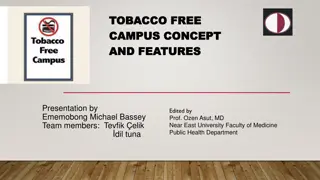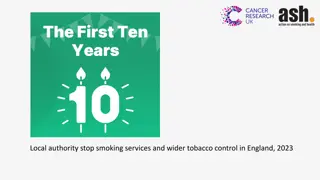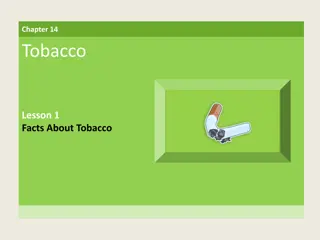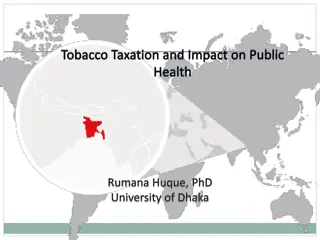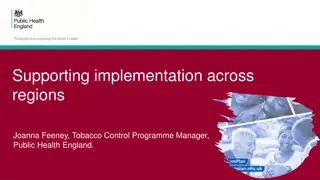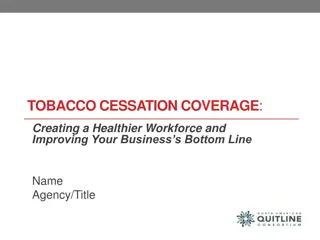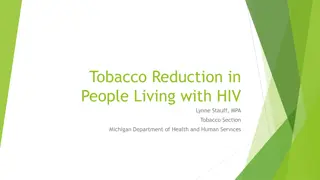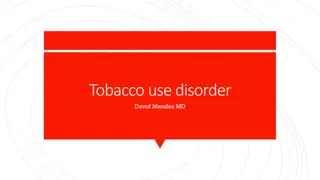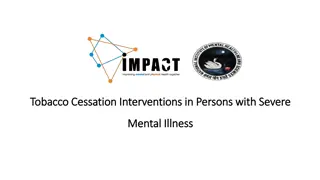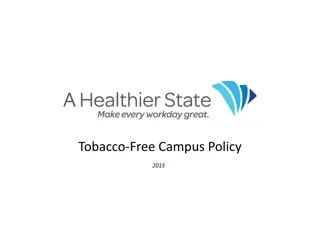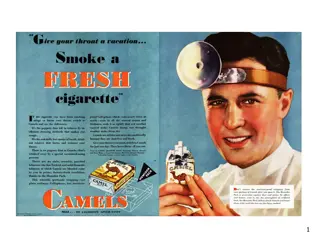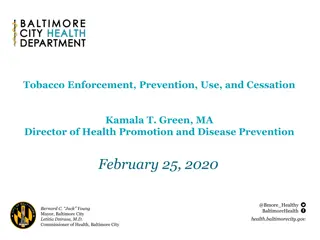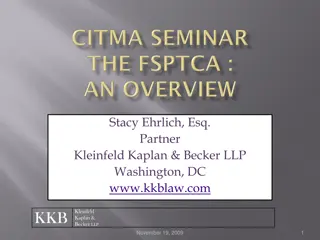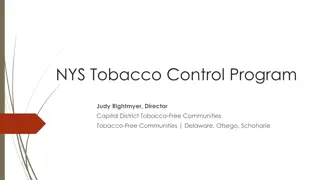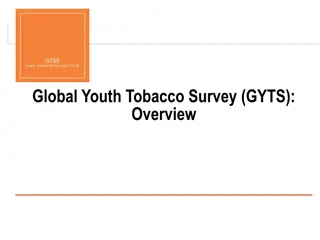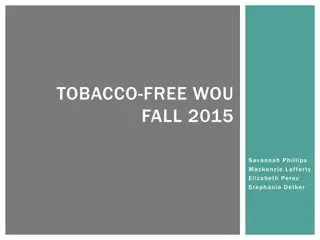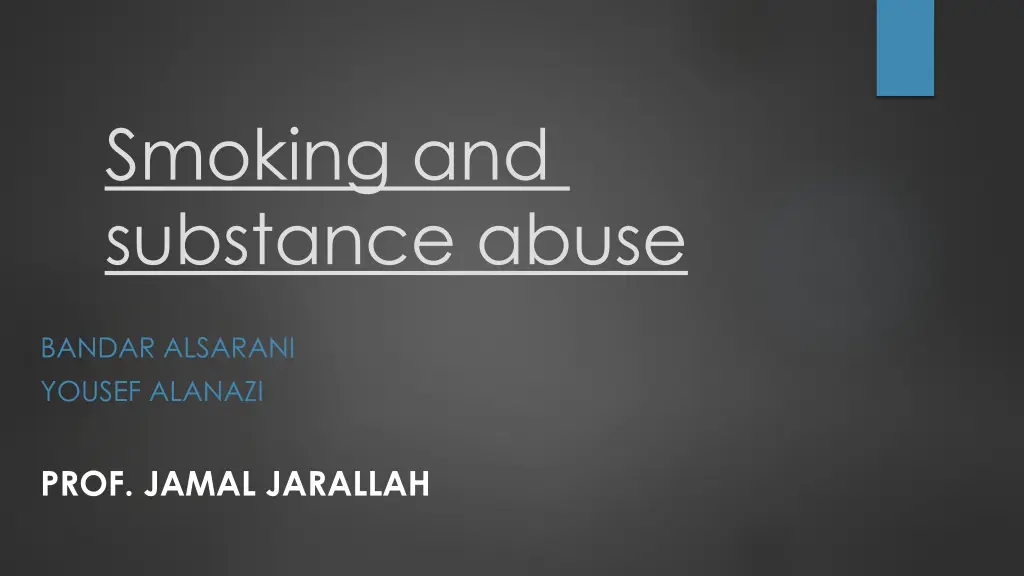
Understanding Smoking and Substance Abuse: Risks, Prevention, and Treatment
Discover the epidemiology of smoking in Saudi Arabia, the risks associated with smoking, and the impact of passive smoking. Learn effective ways to help smokers quit, overcome withdrawal symptoms, and the role of primary healthcare physicians in smoking cessation clinics. Explore pharmacological management, nicotine replacement therapy, and common drugs abused. Uncover the primary addicting substance in cigarettes and understand why smokers start smoking.
Download Presentation

Please find below an Image/Link to download the presentation.
The content on the website is provided AS IS for your information and personal use only. It may not be sold, licensed, or shared on other websites without obtaining consent from the author. If you encounter any issues during the download, it is possible that the publisher has removed the file from their server.
You are allowed to download the files provided on this website for personal or commercial use, subject to the condition that they are used lawfully. All files are the property of their respective owners.
The content on the website is provided AS IS for your information and personal use only. It may not be sold, licensed, or shared on other websites without obtaining consent from the author.
E N D
Presentation Transcript
Smoking and substance abuse BANDAR ALSARANI YOUSEF ALANAZI PROF. JAMAL JARALLAH
Objectives: Epidemiology of smoking in Saudi Arabia Risks of smoking (Morbidity and Mortality) Effect of passive smoking on pregnancy, children, . How are you going to help the smoker to quit and how to overcome withdrawal symptoms Role of PHC physician smoking cessation clinic Update in pharmacological management, smoking cessation medication Nicotine preparations, Varniciline, Bupropion. Factors lead to substance abuse Highlight on types of substance abuse How to approach subjects with substance abuse
Q1- which one of the following is Not way to overcoming nicotine withdrawal symptoms? A. Know smoking triggers and avoid them (avoid stress, caffeine). B. Nicotine Replacement therapy. C. Do regular exercises and keep your self active. D. Set in place with smokers.
Q2- Compared to non-smokers, women who smoke during pregnancy have an increased risk of which of the following conditions? A. Low birth weight baby (<2500g) B. Pre-term birth. C. Sudden Infant Death syndrome (SIDS). D. All of the above.
Q3- What is the most effective pharmacological medication in quitting smoking ? A.Nicotine replacement therapy. B. Bupropion. C.Varenicline. D.Clonidine.
Q4- What is the most commonly abuse drugs ? A. Marijuana. B. Heroin. C. Cocaine. D. Methamphetamine.
The primary addicting substance in cigarettes is nicotine. But cigarette smoke contains thousands of other chemicals that also damage health.. There are more than 5,000 chemical components found in cigarette smoke
Why they get smoking? Three of the main reasons that young people smoke are: To look mature: Since teens see older people all around them smoking, especially their parents and relatives, they smoke to act older. To be like their friends: If their friends or peers smoke, they may feel pressured into doing the same to be accepted. To experiment: the excitement of experimenting with something that is forbidden. Stress relief: Some people initiate tobacco use because they believe that it helps them cope with personal problems or boredom the beginning as a experiment then it will become a habit
Epidemiology of smoking in Saudi Arabia
Current tobacco use among Saudis in 2013 . A study was conducted on 10735 individuals aged 15 years or older. Overall prevalence of current smoking was 12.2 % Male 21.5% Female 1.1% Mean age of smoking initiation was 19.1 years. https://www.ncbi.nlm.nih.gov/pmc/articles/PMC4491232/
what are the Risks of Smoking?
SMOKING INCREASES THE RISK OF DEVELOPING MORE THAN 50 SERIOUS HEALTH CONDITIONS. SOME MAY BE FATAL AND OTHERS CAN CAUSE IRREVERSIBLE LONG-TERM DAMAGE TO YOUR HEALTH. HEART DISEASE: A 2 4 TIMES HIGHER CHANCE OF SUFFERING FROM HEART DISEASE OR HAVING A STROKE THAN NON-SMOKERS. BOTH CONDITIONS CAN LEAD TO SERIOUS COMPLICATIONS AND DEATH. LUNG CANCER: A 25 TIMES HIGHER CHANCE OF DEVELOPING LUNG CANCER AS A RESULT OF SMOKING. HEART FAILURE: SMOKING CAUSES BLOOD VESSELS TO THICKEN. THIS MAKES IT HARDER FOR THE HEART TO PUMP OUT BLOOD AND CAN LEAD TO DEADLY HEART FAILURE. THE CONDITION IS NOTICEABLE EVEN AMONG SMOKERS WHO SMOKE LESS THAN FIVE CIGARETTES A DAY. DIABETES MELLITUS : ACTIVE SMOKERS HAVE A 40% HIGHER CHANCE OF DEVELOPING DIABETES. IN ADDITION TO THAT, ACTIVE SMOKING MAKES IT HARDER TO CONTROL AND MANAGE THE DISEASE.
Smoking causes about 90% of lung cancers. It also causes cancer in many other parts of the body, including the: Mouth, lips, throat, esophagus, bladder, kidney, liver, stomach, pancreas Smoking cause heart diseases, increasing the risk of developing conditions such as: coronary heart disease , stroke , peripheral vascular disease Smoking also causes lungs disease , leading to conditions such as: chronic obstructive pulmonary disease (COPD), which incorporates bronchitis and emphysema
Effect of passive smoking on pregnancy and children :
Passive Smoking: also known as second hand smoking or environmental tobacco smoke, is created through the exhaled particles of an active smoker. Passive smoking can increase a non-smoker's risk of getting lung cancer by a quarter, and may also increase the risk of cancers of the larynx (voice box) and pharynx (upper throat). 17.2% of Saudis are exposed to secondhand smoking at home.
How does passive smoking affect children? Children exposed to passive smoke are at higher risk of respiratory infections, asthma, bacterial meningitis. 94% sudden infant death syndrome 60% acute respiratory illnesses 24 40% chronic respiratory symptoms 21% asthma and exacerbation of asthma symptoms growth in lung functioning 50% recurrent otitis media (repeated ear infection) 60-100 % cleft palate
Passive smoking and pregnancy : 1. Miscarriage. 2. Premature Birth. 4. Sudden Infant Death Syndrome (SIDS): the sudden, unexplained, and unexpected death of an infant before 1 year of age. 3. Low Birth Weight: because cigarette smoke can restrict the growth of the fetus in the uterus.
How to Help the smoker to quit with smoking cessation aids and overcoming nicotine withdrawal symptoms?
The National Cancer Institute recommends that these five steps be a part of every successful plan to quit smoking: START S- Set a quit date. T-Tell family, friends, and coworkers you plan to quit. A- Anticipate and plan for the challenges you will face while quitting. R- Remove cigarettes and other tobacco products from your home, car and workplace. T- Talk to the doctor about getting help to quit.
The five major steps to intervention are the "5 A's": Ask - Identify and document tobacco use status for every patient at every visit. Advise - In a clear, strong, and personalized manner, urge every tobacco user to quit. Assess - Is the tobacco user willing to make a quit attempt at this time? Assist - For the patient willing to make a quit attempt, use counseling and pharmacotherapy to help him or her quit. Arrange - Schedule follow up contact, in person or by telephone, preferably within the first week after the quit date.
Smoking withdrawal Nicotine is the addictive substance in cigarettes that makes people who smoke want to keep on smoking. Withdrawal symptoms are the way smoker s body reacts when it stops getting nicotine and all the other chemicals in tobacco smoke. Factors such as how long you used tobacco and how much tobacco you use on a daily basis will impact the severity of your symptoms. Smoking withdrawal symptoms : Sweating Headaches Insomnia Coughing Difficulty in concentrations, Anxiety Weight gain
How to overcoming nicotine withdrawal symptoms? Know smoking triggers and avoid them (avoid stress, caffeine). Nicotine Replacement therapy. Do regular exercises and keep your self active. Relaxation techniques. Change diet ( add fibers and drink plenty fluids.
Update in pharmacological management and smoking cessation medication:
Strategies for assisting smoking cessation include behavioral counselling and pharmacological intervention. Three drugs are currently used as first line pharmacotherapy for smoking cessation: 1- nicotine replacement therapy. 2- bupropion. 3- varenicline. Second line therapy : Clonidine and nortriptyline
nicotine replacement therapy: nicotine is considered to be the main tobacco compound that causes and sustains addiction to tobacco. Nicotine administration has been shown to reverse nicotine/tobacco withdrawal symptoms. A Cochrane review of 132 trials concluded that all forms of NRTs increase the chances of quitting successfully by 50 to 70 percent.
What is the most effective type of nicotine replacement therapy ?
No single nicotine replacement therapy is most effective for all smokers. All forms of nicotine replacement therapy are equally effective, increasing smoking cessation rates by about 150% to 200%. Higher doses increase quit rates in heavy smokers. Contraindications ? 1. Pregnancy. 2. Breastfeeding.
Bupropion: Bupropion SR was the first licensed non-nicotinic pharmacological therapy for smoking cessation. blocks norepinephrine and dopamine re-uptake in the mesolimbic system, also an antagonist of nicotinic receptors. smokers treated with bupropion should aim to quit approximately 1 week after the start of treatment. One meta-analysis has shown a significant increase of efficacy when bupropion is added to standard nicotine patch therapy. Side effect of Bupropion: insomnia, dry mouth A Cochrane review of 19 randomized trials showed that bupropion doubles the odds of smoking cessation compared with placebo
Varenicline : is a partial agonist of the alpha4/beta2 subtype of the nicotinic acetylcholine receptor. Varenicline is the most recently approved treatment for smoking cessation. Varenicline increases the chances of a successful quit attempt two- to threefold compared with no pharmacologic assistance.
1) Genetics: According to the American Psychological Association genes are important in addiction genetic factors contribute to about half of a person s tendency to become addicted. 2) Environment: There are several factors that play into this: divorce frequent arguments Availability of the drugs.
3) Trauma : neglect verbal abuse physical abuse sexual abuse physical altercations natural disasters accidents
4) Mental Illness: According to the National Alliance on Mental Illness, more than one half of substance abusers are also dealing with a mental illness 5) Peer Pressure: The Health Psychology Journal reported that poor self control can be linked to having difficulty interacting with others, and drug use can help numb that particular pain.
Highlight on types of substance abuse: Alcohol: alcohol actually depresses the brain and decreases muscle control and coordination, and may lead to alcoholism. Marijuana: the most commonly used illegal drug in the United States, it contains more cancer causing chemicals than tobacco smoke. Cocaine: cases constriction of blood vessels leading to heart damage or stroke, irregular heartbeat, and death.
Heroin: Effects of heroin intoxication include drowsiness and slowed breathing. Overdose may result in death from respiratory arrest. Methamphetamine: is a powerful stimulant that increases alertness. It shares many of the same toxic effects as cocaine : heart attacks, dangerously high blood pressure, and stroke
How to approach subjects with substance abuse
Before an addict can begin a rehabilitation program, full withdrawal or detoxification may be necessary. The most commonly used treatment options for substance abuse include: 1) Psychotherapy, which helps patients learn how to resist and redirect compulsions. 2) Support groups. 3) Individual counseling.
Q1- which one of the following is Not way to overcoming nicotine withdrawal symptoms? A. Know smoking triggers and avoid them (avoid stress, caffeine). B. Nicotine Replacement therapy. C. Do regular exercises and keep your self active. D. Set in place with smokers.
Q2- Compared to non-smokers, women who smoke during pregnancy have an increased risk of which of the following conditions? A. Low birth weight baby (<2500g) B. Pre-term birth. C. Sudden Infant Death syndrome (SIDS). D. All of the above.
Q3- What is the most effective pharmacological medication in quitting smoking ? A.Nicotine replacement therapy. B. Bupropion. C.Varenicline. D.Clonidine.
Q4- What is the most commonly abuse drugs ? A. Marijuana. B. Heroin. C. Cocaine. D. Methamphetamine.
Ahmed is 55 years old, diabetics and hypertensive, he has been a smoker for 30 years.
1. https://www.ncbi.nlm.nih.gov/pmc/articles/PMC4491232/ 2. http://www.aafp.org/afp/2012/0315/p591.html#afp20120315p591-b27 3. https://www.ncbi.nlm.nih.gov/pmc/articles/PMC4014023/#b1 4. https://www.ncbi.nlm.nih.gov/pmc/articles/PMC2528204/ 5. http://americanpregnancy.org/pregnancy-complications/second-hand-smoke-and- pregnancy/ 6. http://www.bmj.com/content/340/bmj.c1680 7. https://www.ncbi.nlm.nih.gov/pmc/articles/PMC4028571/ 8. https://journals.rcni.com/primary-health-care/smoking-cessation-phc.2017.e1283 9. https://www.cancer.org/cancer/cancer-causes/tobacco-and-cancer/health-risks-of-smoking- tobacco.html 10.https://www.ncbi.nlm.nih.gov/pubmed/?term=PMC4014023 11.https://drugabuse.com/library/get-the-facts-on-substance-abuse/ 12.http://www.mdedge.com/jfponline/article/60156/addiction-medicine/what-most-effective- nicotine-replacement-therapy 13.http://www.heart.org/HEARTORG/HealthyLiving/QuitSmoking/QuittingSmoking/Smoking-Do- you-really-know-the-risks_UCM_322718_Article.jsp# https://www.webmd.com/mental-health/addiction/substance-abuse#1


